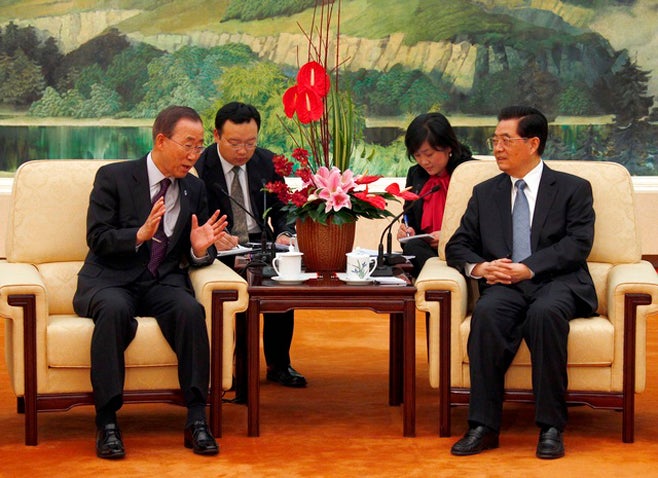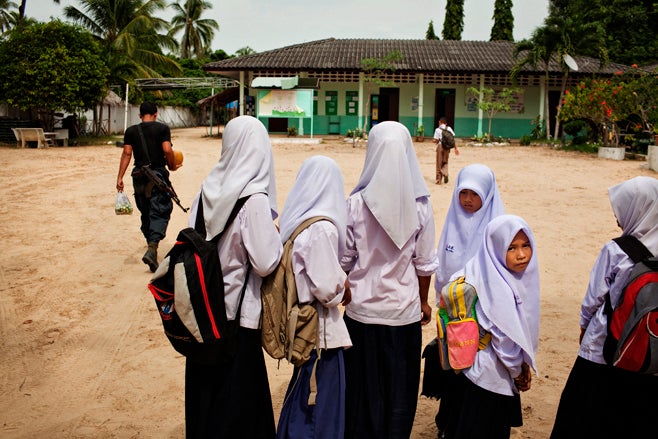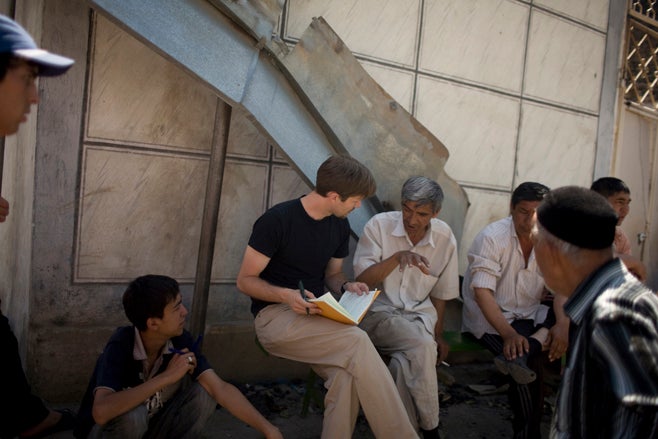By Carroll Bogert
Download the 2011 World Report [PDF, 4 MB]
These are tough times for foreign correspondents. A combination of rapid technological change and economic recession has caused deep cuts in the budget for foreign reporting at many Western news organizations. Plenty of ex-foreign correspondents have lost their jobs, and many others fear for their jobs and their futures. Consumers of news, meanwhile, are watching international coverage shrink in the pages of major papers. One recent study estimated that the number of foreign news stories published prominently in newspapers in the United Kingdom fell by 80 percent from 1979 to 2009.[1] The Organization for Economic Co-operation and Development estimates that 20 out of its 31 member states face declining newspaper readerships;[2] since foreign reporting is expensive, it is often the first to be cut.
While changes in the media world may be hard on journalists and unsettling for news consumers, they also have very significant implications for international NGOs such as Human Rights Watch. Foreign correspondents have always been an important channel for international NGOs to get the word out, and a decline in global news coverage constitutes a threat to their effectiveness. At the same time, not all the implications of this change are bad. These are also days of opportunity for those in the business of spreading the word. This essay attempts to examine the perils and possibilities for international NGOs[3] in these tectonic shifts in media.
Of course NGOs of all kinds accomplish a great deal without any recourse to the media at all. Human rights activists pursue much of their mission outside the public eye: private meetings with diplomats; closed-door policy discussions with government officials; strategy sessions with other NGOs; and, of course, interviews with victims and eyewitnesses whose identity and safety must be protected from the glare of publicity. NGOs that do research in the field may share a close bond with journalists, but research is only part of their overall mission of effecting social change.
Not all NGOs deal regularly with foreign correspondents; in fact, quite the opposite. Most NGO activists are working inside their own national borders. If the local media are at least somewhat free, they are likely to be more focused on national coverage. The international or regional media may serve as an additional form of pressure on the activists' own government, but changes in the funding and composition of foreign correspondents will not always have a significant impact on their work.
NGOs have a complex and ambivalent relationship with journalists. They work at a different pace from the media, take a considerably longer time to publish their findings, and feel far removed from the feeding frenzies and 15-minute celebrities that often dominate commercial media. They frequently feel that in the rush of the news cycle, key facts may get forgotten or taken out of context, and the headline-grabbing aspects of the story may not be the most meaningful or important angles for their own advocacy.
At the same time, with a few exceptions, NGOs are constantly seeking greater media attention for their work. The changing media landscape presents new challenges and possibilities for such groups, particularly those that view international media as an important channel for getting their message out.
NGOs and Foreign Correspondents: A Symbiosis
One of the most potent tools of international human rights NGOs has always been "naming and shaming," or publicizing specific human rights violations and identifying those responsible. Its usefulness can be measured in part by the resources governments mobilize to combat it. At the United Nations Human Rights Council in Geneva, for example, government delegations conduct extensive diplomatic campaigns to avoid being publicly censured.
Bad publicity can help spark government action. When a video surfaced in October 2010 showing two Papuan farmers being tortured by Indonesian soldiers, the Indonesian government clearly felt pressure to act. United States President Barack Obama was scheduled for a visit that month and neither government wanted the torture issue to dominate the headlines. The Indonesian government, which has been notoriously reluctant to punish its soldiers for human rights abuses, promptly tried and convicted four soldiers of torture.[4] It was clearly responding to media pressure in doing so.
For groups that do not enjoy extensive grass-roots support or mass membership, media coverage may act as a kind of stand-in for public pressure. In very few countries, and relatively rare circumstances, does the public become seriously mobilized over an issue of foreign policy. To be sure, the Israeli-Palestinian conflict has the capacity to rally global publics outside the region-on both sides-and so does the use of US military power abroad. The Save Darfur campaign brought hundreds of thousands of students and other supporters to street demonstrations. But those are exceptions. In general, foreign affairs pique the interest of a narrow subsection in any society. Extensive media coverage of an issue may help to affect policy even when the public remains silent on the issue. Serbian atrocities in Kosovo at the end of the 1990's comes to mind; significant public debate, in the media and elsewhere, helped generate pressure on NATO policymakers to take action.
Media coverage can also act as an informal "stamp of approval" for international advocacy groups. When a prominent publication cites an NGO official in a story, it signifies that the reporter, who is supposed to be knowledgeable about the issue, has determined the NGO to be credible. When an NGO spokesperson appears on a well-regarded television show, she may thereafter carry greater weight with the policymakers she is trying to reach. Her very access to the media megaphone makes her a bigger threat, and a person to be reckoned with.
If advocacy groups need the media, it is clear that media need them, too. In many countries where the press corps is not fully free, journalists rely on international groups to say things that they cannot. In Bahrain, for example, the ruling family promotes itself as reformist but it would have been very difficult for the one independent local newspaper there to report extensively on renewed use of torture during police interrogations. The fact of this resurgence was widely alleged by activists and detainees, but considered too sensitive to publicize locally. When Human Rights Watch published a report on the issue,[5] the local independent newspaper covered the issue extensively, reproducing much of the report in its pages without major fear of retribution.
Foreign correspondents working in repressive countries do not face the same consequences that local journalists do when they report on human rights or social justice issues. But they, too, may pull their punches in order to avoid problems with their visas or accreditation. Quoting an NGO making critical comments is safer than doing so oneself.
Some journalists feel a strong bond of kinship with NGOs that work on political repression and abuse of power. Whether it was Washington Post correspondents Bob Woodward and Carl Bernstein bringing the Watergate crimes to light, or the international press corps covering the wars in the former Yugoslavia, journalists are often driven by the desire to expose the crimes of political leaders and see justice done.
Whose Sky is Falling?
Paradoxically, it is precisely in wealthier countries where the media are sickest today. In the United States, the triple blow of the internet, the economic recession, and the poor management of a few major newspapers has dramatically shrunk the cadre of foreign correspondents. Several daily papers, such as the Boston Globe and Newsday, have shut down their foreign bureaus entirely. Television networks have closed almost all of their full-fledged bureaus, leaving local representatives in a handful of capitals. The New York Times and The Washington Post, the reigning monarchs of international coverage, appear to maintain their foreign bureaus more out of the personal commitment of the families who still own them. In the United States, at least, the commercial model for international fact-gathering and distribution is evidently broken.
No one is more vocal about the dire consequences of these cutbacks than the newspapers' foreign correspondents themselves. Pamela Constable, a respected foreign correspondent for The Washington Post, wrote in 2007: "If newspapers stop covering the world, I fear we will end up with a microscopic elite reading Foreign Affairs and a numbed nation watching terrorist bombings flash briefly among a barrage of commentary, crawls, and celebrity gossip."[6] As The New York Times' chief foreign correspondent said: "When young men ask me for advice on how to become a foreign correspondent, I tell them: ‘Don't.' It is like becoming a blacksmith in 1919-still an honorable and skilled profession; but the horse is doomed."[7]
But the correspondent, C.L. Sulzberger, made that comment in 1969. Every age laments its own passing, and old foreign correspondents are no exception. It is not entirely clear that the American public, or the public in any of the countries where foreign correspondents are in decline, is less well-informed than it used to be. At least one study has shown, in fact, that the American public is roughly as informed about international affairs as it was 20 years ago, before the big declines in traditional sources of foreign reporting.[8] And overall, even among Western publics, media consumption is increasing.[9]
Meanwhile, in countries such as Malaysia, Singapore, Vietnam, and others, the internet is allowing the public to get foreign news without government filters-an important advance in their knowledge of the world.[10] And the OECD has estimated that, while readership of newspapers is declining among most of its members, that decline is more than offset by the overall growth in the newspaper industry globally.[11]
A number of media outlets from the global South have greatly enhanced their international presence in recent years. Al-Jazeera and al-Jazeera English, financed by the emir of Qatar, report on a wide range of global news, although the network has recently cut back one of its four international broadcasting centers. Others are not so free-wheeling. Xinhua, the state-run news agency of China, and other Chinese media organizations such as CCTV, are loathe to run much human rights news-and are positively allergic to such news out of China or its allies.
A Peril and a Boon
The information revolution made possible by the internet represents both a peril and a boon to international NGOs grappling with the decline in Western media reporting on foreign news. On the one hand, the plethora of online publications, blogs, Facebook, and Twitter feeds, cable and satellite television stations, and other forms of new media is clamorous and confusing. How are advocacy groups to know which media are important? If one purpose of getting media coverage, as laid out above, is to reach policymakers, how does one ascertain which media they are consuming? Previously, in most countries, a couple of daily papers, a weekly magazine or two, and a few radio and television broadcasts constituted the core of what critical decision-makers in government were likely to get their news from. Nowadays their reading habits are not so easy to guess. The audience for international news has fractured.
A 2008 study by graduate students at Columbia University asked a range of officials associated with the UN in New York what media they read, listened to, and watched. Unsurprisingly, nearly three-quarters of those surveyed said they read The New York Times every day. Fifty percent read The Economist-also no surprise. But a significant number of respondents said they were also reading the frequent postings of a blogger at the Inner City Press, who covers UN affairs closely but is virtually unknown outside the UN community.[12]
The internet poses the challenge of the glut. Advocacy groups, after all, not only seek media coverage but also respond to media queries. Which questioners are worthy of the scarce attentions of an NGO? Which bloggers are merely cranks who will waste an inordinate amount of staff time while offering little impact? And how does one tell the difference? And how much time should an NGO spend poring through the latest data-dump from Wikileaks?
But then there is the boon. The same internet that has blown a gaping hole in media budgets is also allowing NGOs to reach their audiences directly. Technologies that were once the exclusive preserve of a professional class are now widely available. Taking a photograph of a policeman beating up a demonstrator and transmitting the image to a global audience used to involve expensive equipment and access to scarce transmission technology. Only a handful of trained journalists could do it. Now the same picture can be taken and transmitted with a US$35 mobile phone. During Egypt's parliamentary elections in late November 2010, for example, the government rejected international observers and drastically restricted local monitors. But NGO activists managed to film a local mayor affiliated with the ruling party filling out multiple ballots and, in another place, plainclothes men with sticks disrupting a polling station.
Picking Up the Slack?
For NGOs with large field presences-and even for those with only an occasional investigator or representative overseas-the ability to generate and distribute content is potentially revolutionary. But it requires more than taking a cell-phone photograph of a news event and posting it to Facebook. The question is whether NGOs will operate systematically in the vacuum left by the commercial media. To do so will require re-purposing the information they are already gathering, and acquiring the skills to reach the public directly with features capable of attracting public attention. At present not many NGOs have the resources to reconfigure their research and information into user-friendly content. Most of them operate on the written word. Often they are addressing other experts rather than the public at large. Importantly, they generally have precious little visual information to illustrate their findings.
That is beginning to change. Human Rights Watch assigns professional photographers, videographers, and radio producers to work in the field alongside its researchers, documenting in multimedia features what the researchers are documenting in words. [13]
Amnesty International is creating an autonomous "news unit," staffed with five professional journalists, to generate human rights news. Medecins Sans Frontieres also uses photography and video extensively, while the Natural Resources Defense Council is assigning journalists to write about environmental issues.
Even if NGOs are able to produce user-friendly content, the question remains of how to distribute it. An NGO can post content on its website, and reach a few thousand people, perhaps tens of thousands. Distributing via Facebook, Twitter, YouTube, and other social media might garner a few thousand more. Content that "goes viral" and reaches millions of people remains the rare exception. Sooner or later the question of distribution returns to the mainstream media, whose audiences still dwarf those of the non-profit sector. Will they distribute content produced by NGOs?
With budgets for foreign news in decline, one might expect editors and producers to be grateful for the offer of material from non-profit sources. But that is not always the case, and the answer depends on the country, the media outlet, and the NGO. The BBC, for example, rarely takes material from advocacy groups for broadcast. CBS, in the US, recently tightened up its regulations for taking content from outside sources.[14] Time magazine will not accept images from a photographer whose assignment was underwritten by an NGO.
And many media commentators, writing on the rising importance of NGOs as information producers, are wary of the trend. "While journalists-if sometimes imperfectly-work on the principle of impartiality, the aid agency is usually there to get a message across: to raise money, to raise awareness, to change a situation."[15]
Issues of Objectivity and Neutrality
NGOs like Human Rights Watch do not present facts for the sake of reporting the news but to inform the public and advocate on behalf of victims of abuse. That sets their work apart from traditional journalism and raises the very important question of whether the information being gathered and conveyed by these NGOs is less trustworthy. Unless the NGO is transparent about its aims, about the provenance of the material it is distributing, and about the standards it uses in its own information-gathering, the consumer-whether a journalist or a visitor to the website-will be justifiably wary.
The best media professionals spend their entire careers trying, as hard as they can, to rid their own reporting of bias and to be fair to all sides. They believe, and they are correct, that unbiased information is a genuine public good and that biased information can mislead readers, including policymakers, into bad decisions-even social strife and violence. Many media training organizations in conflict zones around the world are struggling to instill the notion of unbiased reporting in media environments where the lack of it has proved disastrous. At the same time few people believe that the American media, where the culture of neutral and apolitical reporting has been most fiercely propagated, are in fact unbiased.
Research-driven NGOs put a premium on rigorous, factual reporting. If they play fast and loose with the facts, they lose credibility and so lose traction with policymakers. Their reputations depend on objective reporting from the field. At the same time, they work in service of a cause, advocating on behalf of victims and seeking accountability for perpetrators. While different NGOs have different standards for gathering, checking, and vetting information, the entire purpose of that information is to act to protect human dignity. Those who gather information must do so impartially, from all sides, but they are not neutral towards atrocity.
Media organizations and advocacy groups stay independent of each other for good reason. They are pursuing different objectives. Journalists' refusal to distribute content produced by others protects against the partisan abuse of the media space. Meanwhile, international advocacy groups are wary of drifting from their core mission into the media business. But changes in technology and commerce, at least in some countries, are pushing them closer together.
To the extent that NGOs do produce more user-friendly content, they must keep in mind a few principles for establishing their credibility: first, transparency in the methods of collecting the information; second, a proven track record and a reputation, over many years, for reliable research; and third, complete openness about the aims of the organization and the fact of its authorship.
NGOs still face the question of how far they want to go in creating user-friendly content. Few seem inclined to reorient their identities as information producers in the new information age. Filling the vacuum in international news takes money, and most NGOs struggle to meet their existing budgets, let alone expand into areas that seem tangential to their central mission. But if they turn their backs on the trend, they will miss a critical opportunity to be heard.
This information revolution has big implications for more than just a handful of advocacy groups. Any entity that produces denser material written for a more specialist audience must now realize that the legions of those who will transform it into something the layperson can understand-in other words, a work of journalism-are now much diminished. To have maximum impact in the world today, information must be repurposed and refashioned for multiple audiences and platforms, like a seed sprouting in every direction. That is a trend that no one who cares about influencing public opinion can afford to ignore.
Carroll Bogert is the deputy executive director, external relations, of Human Rights Watch.
[1] Martin Moore, Shrinking World: The decline of international reporting in the British press (London: Media Standards Trust, November 2010), p 17. The study looked at foreign stories appearing in the first ten pages of four major daily newspapers.
[2] Organisation for Economic Co-operation and Development: Directorate for Science, Technology and Industry Committee for Information, Computer, and Communications Policy, "The Evolution of News and the Internet," June 11, 2010 http://www.oecd.org/dataoecd/30/24/45559596.pdf (accessed November 20, 2010), p.7. The steepest declines were registered in the United States, the United Kingdom, Greece, Italy, Canada, and Spain.
[3] This essay focuses primarily on NGOs that do research and advocacy in multiple countries and therefore interact regularly with journalists who cover one country for audiences in another. Most of these remarks concern NGOs working on human rights and other social justice issues, rather than, for example, global warming and the environment, although they face some of the same challenges.
[4] The four were actually convicted of torture that was revealed in another, unrelated video. See "Indonesia: Investigate Torture Video From Papua," Human Rights Watch news release, October 20, 2010, http://www.hrw.org/en/news/2010/10/20/indonesia-investigate-torture-video-papua.
[5] Human Rights Watch, Torture Redux: The Rivival of Physical Coercion during Interrogations in Bahrain, February 8, 2010, http://www.hrw.org/en/reports/2010/02/08/torture-redux
[6] Pamela Constable, "Demise of the Foreign Correspondent," The Washington Post, February 18, 2007.
[7] John Maxwell Hamilton, Journalism's roving eye: a history of American foreign reporting (Lousiana State University Press, 2010), p. 457.
[8] "Public Knowledge of Current Affairs Little Changed by News and Information Revolutions: What Americans Know: 1989-2007," The Pew Research Center for the People & the Press, April 15, 2007 http://people-press.org/report/319/public-knowledge-of-current-affairs-little-changed-by-news-and-information-revolutions (accessed November 29, 2010).
[9]Richard Wray, "Media Consumption on the Increase," The Guardian, April 19, 2010 http://www.guardian.co.uk/business/2010/apr/19/media-consumption-survey (accessed November 21, 2010).
[10] See, for example, the Temasek Review in Singapore; Malaysiakini and other online portals in Malaysia; numerous Vietnamese bloggers; and the Democratic Voice of Burma and Mizzima, among others.
[11] OECD, 2010
[12] "Mass Media and the UN: What the Advocacy Community Can Do to Shape Decision Making," Columbia University School of International Public Affairs, May 2009, on file at Human Rights Watch. The respondents came from the UN Secretariat, various UN departments whose work touches on human rights, and diplomats representing 12 of the 15 UN Security Council members.
[13] Many photographers now raise money from foundations to partner with NGOs. Among the most active donors, for example, is the Open Society Institute's Documentary Photography Project: http://www.soros.org/initiatives/photography (accessed November 20, 2010); photographers at Magnum are increasingly willing to "partner... with select charitable organizations and provid[e] free or reduced rate access to the Magnum Photos archive," http://magnumfoundation.org/core-programs.html (accessed November 20, 2010).
[14] Private conversation with CBS producer, October 2010.
[15] Glenda Cooper, "When lines between NGO and news organization blur," Nieman Journalism Lab, December 21, 2009, http://www.niemanlab.org/2009/12/glenda-cooper-when-lines-between-ngo-and-news-organization-blur/ (accessed November 20, 2010).




